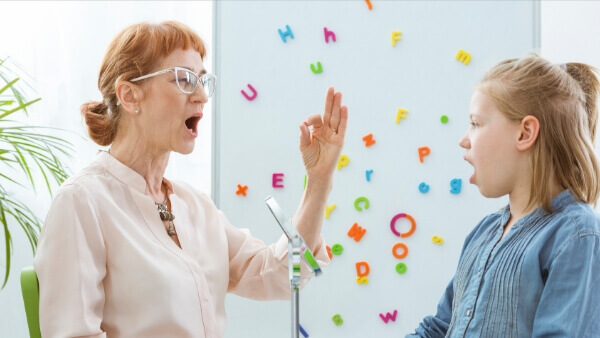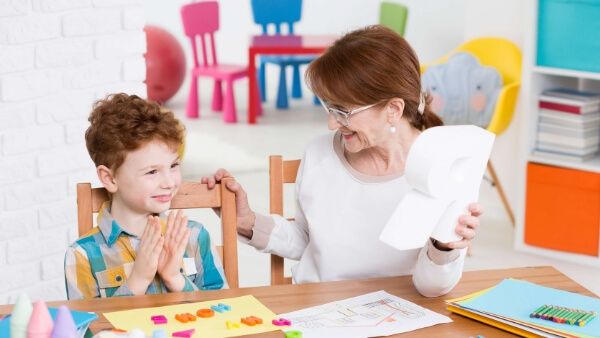How parents can give speech therapy to kids (at home)?

Introduction:
If your child has a speech disability that includes trouble pronouncing words, speech therapy may help improve language development, communication, and pragmatic language skills. Here is all that you need to know, and how you can help your child by giving him/her speech therapy.
What is speech therapy?
Speech therapy is a language intervention method that focuses on improving a child’s speech, and overcome problems like poor articulation, disfluency (repetition of a sound, word, or phrase), and phonological and voice disorders. It helps a child express themselves better through verbal and non-verbal language. It focuses on:
1. Articulation and fluency to form sounds, words, and sentences
2. Regulation of the volume of speech
3. Expressive language through pictorials, signs, and written forms
Does my child need speech therapy?
Some children may have excellent pronunciation skills and may even be early readers, but they may need speech therapy to improve “pragmatic” language, or the process of using verbal and body language appropriately for carrying out day-to-day activities
Other reasons include medical conditions such as a brain injury or infection that has affected the ability to communicate and an identifiable disability such as Down syndrome. Symptoms are often seen at a young age and continue as children enter school and learn to write. In general, children are reluctant to talk or talk with breaks. It is difficult to understand what they want to say. But it doesn’t mean the child needs therapy.
What do speech and language pathologists do?

An SLP may identify a language-based learning disability in students who struggle to read and express themselves in written work. Language difficulties can have a major impact on a child’s ability to write. In order to write, children must be able to put their ideas into words and organize those words into sentences. Also, language challenges make it hard for children to understand and follow directions. An SLP can help them build these skills.
To provide direct treatment, SLPs perform evaluations and consult with teachers to create language-rich classrooms. Therapy may be individual or include a small group of peers who face similar social and communication challenges. In either situation, the goal is to make language fun, develop friendships, and enable students to succeed in school.
When is speech-language pathologist needed?

You need to understand the levels of the problem when speech therapy becomes necessary. Here are the criteria:
1. People find it difficult to understand what their child says.
2. Your child struggles in uttering words or translating their thoughts into words.
3. The child’s speech is disturbed with stuttering, repetition or prolongation.
4. Your child has not developed on social skills like making friends, having direct contact, learning play skills, and engaging with others.
Your child may have perfect pronunciation and may also be a good reader. But they may still need speech therapy to hone their pragmatic language skills or the process of using language aptly in social scenarios to have a conversation, make new friends or simple requests to someone. A child may also need speech therapy due to disabilities, or medical conditions like autism or hearing impairment as they affect the ability to communicate.
Speech Therapy Programs:
Speech and language pathologists not only assess and treat for articulation, language, and cognitive difficulties, but also focus on swallowing and feeding. It is common among children having trouble with the speech to also have feeding challenges. While children with special needs may be the first to come to mind, it is not unusual for other kids to have both speech and feeding difficulties. Both speech and eating involve fine motor aspects of moving the tongue, jaw, and lips in a coordinated fashion. The SLP might bring out some blow toys and whistles to strengthen muscles used in speech and eating.
Tips for parents on speech therapy at home:

Even if your child is enrolled in a speech therapy service, you may still practice speech therapy exercises at home to support the treatment. One of the most important things to do is to avoid any negative comments about your child’s speech. If your child is stuttering, do not pressurize them. Instead, follow the below tips:
1. Encourage conversation:
Ask your child thought-provoking things like, “What would you do if you have a bird for a friend?” By asking questions that extort detailed response, you are encouraging your child to express their ideas.
2. Listen carefully:
Listen to your child with attention even if they are taking the time to complete their sentences. When you are listening, your child gets the confidence to speak. They try their best to talk fluently.
3. Make your child read:
Buy some interesting story books or pick up a news piece that is of interest to your child and ask them to read it aloud. Tell them to repeat it twice or thrice. Such activities foster speaking as well as language skills.
4. Do an assessment:
Evaluate your child and see in which areas your child is struggling. This will help you know if speech issues are standalone or are connected with other developmental problems. You can analyze by comparing your child’s performance with the normal milestones in children of that age.
5. Target areas:
Choose specific problem areas that you want to address and resolve. Keep the goals achievable both for you and your child. Focus on age-specific goals that the children of that age normally reach.
6. Address one sound at a time:
Begin with breaking down a problem into simpler and smaller versions and then teaching them specifically. If you want to teach your child how to use the f sound correctly, start by showing them how to utter the sound first (fff), then teach syllables (fuh/ oof), then move on to words (f for fish) and finally use those words in sentences and conversation.
You can try several activities to improve your child’s speech. But remember that your child should enjoy them. They may not cooperate if they feel bored.
Speech therapy activities & exercises:
1. Flashcards and question cards
Place a few flashcards with pictures in front of your child and ask them to say what they see on the card. Start with a few cards and increase the pictures as you progress. If your child struggles with certain words, you will understand where you need to invest more time. Question cards have simple questions for children. Choose one card at a time and slow down to have a conversation. This can be a grand strategy to pull your child into a conversation.
Mirror exercise:
Mirrors provide visual feedback. Most children with articulation problem do not know how to move their mouth to form sounds accurately. Speaking in front of a mirror helps a child watch how they move their mouth when making that particular sound. Stand in front of the mirror and produce each sound for your child. Then, help them discern the differences through the mirror.
Hop and speak:
This game makes your child repeat the word nine times. Start with the words you want your kid to practice. Draw hopscotch with 1-9 numbers and ask the child to utter the word each time they hop on a number. Once they complete hopping up to 9, change the word and let them hop again, this time with the new word. You can begin with fewer words and increase them gradually. Once they complete the game by saying the words correctly, reward them with a gift to increase confidence.
Guess Who?
This is a fun board game by Hasbro that helps children identify everyday items such as cars, animals, foods and sea creatures. Not only does this game teach problem-solving, but it also encourages proper character identification and socialization skills.
Oral motor exercises:
Oral motor refers to the use of muscles inside the mouth, including the lips, cheeks, jaw, and tongue. All these parts are tied to muscles, which can be strong or weak, coordinated or not coordinated. We need strong oral motor skills to be able to talk, eat, swallow or drink. Here are different oral motor exercises for your child to practice and improve.
1. Lip movements:
These lip movements make up for excellent oral exercise for children.
Say ooh, then eee. Combine “oo-ee.” All these utterances have different movement patterns.
Ask the child to smile big, relax and repeat.
Kids can puff out their cheeks while not opening the lips. Alternatively, they may puff one cheek and rest the other.
The same can be done with lips. Puff the upper lip followed by the lower lip. Relax. Repeat.
Make the child drink from a straw instead of a cup.
2. Tongue movements:
Try these ‘tongue twisters’.
Make your child practice tongue tip sounds like “t-t-t-t,” “d-d-d-d” “p-p-p-p.” Say “go” with exaggeration
Have your child hold their tongue and not rest it on the lips or teeth. They have to tighten the tongue and then relax.
3. Cheek movements:
You can strengthen the child’s cheek muscles with these movements:
Ask your child to keep their lips sealed and contract the cheeks. Make an “o” with the lips and move them in a circular motion. Relax and repeat. You can make him/her use a straw to drink water so that these movements are practiced naturally.
4. Tune the harmonica:
Blowing the harmonica helps in breath-control and lip-pursing. If your child’s breath-control is weak, ask them to make louder sounds from the harmonica, and if their lip strength is weak, focus on playing one note at a time.
Speech therapy activities for pre-schoolers :

- Speak with clarity so that the child learns that from you.
- Repeat what your child speaks to tell them that you understand.
- Add on to what they say. Example: “Mango juice? I have juice. I have mango juice. Do you want mango juice?”
- Use adult words while speaking to your child.
- Help your child understand and ask questions. Play the yes/no game. You may have them come up with sentences like, “I can fly,”
- “A tree can walk”, and then you answer in yes or no.
- Put familiar objects in a box. Have your child take one out at a time and tell you what its name is and how to use it. “This is a pencil.
- I use a pencil to draw sketches. I also write using this pencil.”
Closing thoughts:
You may also use speech development toys or books. Do not be in a hurry to start its implementation. Give them time to improve their speaking skills. You need to be patient and positive while helping your child learn to speak. Children benefit the most when their parents empathize with them.




